Sichuan, China – Saturday, April 2nd to Sunday, April 3rd, 2011
When I was traveling Europe the year before, I spent almost all of my time in built environments of cities or amusement parks. When it came time to prioritize my travel in Asia for 2011, I made a resolution to get outside of the cities and explore some of the natural world the continent presented me. While the presence of a Happy Valley theme park made a trip to Chengdu more attractive for me, the real impetus was the city’s proximity to Jiuzhaigou Valley, one of China’s most famed national parks and a UNESCO World Heritage Site, the Chinese equivalent of Yellowstone or Yosemite. If I was going to experience a national park, I was going to go the extra mile to experience one of the best.
But it’s a lot of extra miles. Although Chengdu is the closest metropolis, Jiuzhaigou is nearly 500km away at the edge of the Tibetan plateau for a 10 hour bus ride in either direction. It’s a minimum 2.5 day excursion.
I got up at the crack of dawn to catch the tour bus I had booked the day prior, silently wondering just what I had gotten myself into, especially to undertake solo without speaking the language. I took my seat and watched the rest of the passengers filed by, feeling completely alienated by language and culture. I wondered how rare was it to see a foreigner like me on this bus? My question was soon answered as I saw another foreign couple pass by, the husband offhandedly remarking in my direction, “look, there’s whitey.” Huh. Well at least that was a brief moment of connection so I don’t feel quite so alone anymore.
Just as the bus got going and I was hoping to catch some sleep,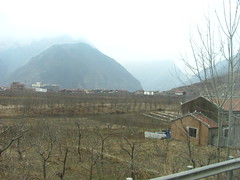 flip screen televisions auto-pivoted from overhead and the bus started playing Chinese pop ballad music videos… very loudly. What was previously a light generalized anxiety had now transformed into a very specific panic—would I be forced to listen to this for the next ten hours?!? After about 45 minutes my prayers were answered as the TVs shut off and retracted, leaving us with the blissful sounds of the road. Whatever happened from here on out was no longer the worst-case scenario.
flip screen televisions auto-pivoted from overhead and the bus started playing Chinese pop ballad music videos… very loudly. What was previously a light generalized anxiety had now transformed into a very specific panic—would I be forced to listen to this for the next ten hours?!? After about 45 minutes my prayers were answered as the TVs shut off and retracted, leaving us with the blissful sounds of the road. Whatever happened from here on out was no longer the worst-case scenario.
All countries have an urban-rural divide, but few divisions are as stark as in China. While cities like Chengdu can look like they’re out of a sci-fi movie, the countryside is very much still part of the developing world. The bus route had no highways leading to Jiuzhaigou, traversing for some segments of the route along narrow dirt roads. At one point the bus even got stuck in a dirt pothole that required the collaborative efforts of several bystanders to dislodge.
We stopped for lunch at what seemed to be a Chinese equivalent of an old roadside rest stop. The bathrooms consisted of a single shared trough along the wall. Best to hurry up with that business. Lunch was served, consisting of a tofu, a veggie, and a mystery meat dish, if I recall, all spicy. Sitting down at the picnic tables, I connected with the couple I saw earlier.  They were from Canada, in the middle of a long trip sightseeing across China. We shared stories of our experiences in this country so far, as well as tips we’d heard about the best way to plan a day at Jiuzhaigou tomorrow. As could be expected they were very nice.
They were from Canada, in the middle of a long trip sightseeing across China. We shared stories of our experiences in this country so far, as well as tips we’d heard about the best way to plan a day at Jiuzhaigou tomorrow. As could be expected they were very nice.
As we drew closer to our destination, the landscape became more dramatic. Another rest stop was along a small roadside market, with a yak and camel out to greet the tourists. China officially recognizes 55 ethnic minorities within its borders. While most of what we associate with modern China comes from the majority Han population (to which Chengdu is a part), moving closer to the western frontier where Jiuzhaigou is located you start to see more of the intercultural influence within China.
 Soon our journey reached the highlands, where the forest grew thick and snow had still fallen on the ground. Interestingly, the infrastructure became more advanced on this last part of the journey, as we took a newly-paved roadway through the hills to reach the Jiuzhaigou Village. Those tourist yuans to Jiuzhaigou were finally becoming evident.
Soon our journey reached the highlands, where the forest grew thick and snow had still fallen on the ground. Interestingly, the infrastructure became more advanced on this last part of the journey, as we took a newly-paved roadway through the hills to reach the Jiuzhaigou Village. Those tourist yuans to Jiuzhaigou were finally becoming evident.
The village at the base of Jiuzhaigou had that well-maintained contemporary rustic feel common to many U.S. National Parks, albeit fitted for a much different culture. The Canadian couple would be staying at one of the local hotels, while I would be checking in at a much cheaper hostel called Uncle Jiang’s Family House, for the equivalent of about $4.50USD per night.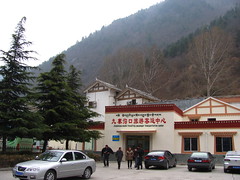
The extremely low price was no cause for concern; the rustic hostel very comfortable and friendly, feeling a bit like a familiar home on the other side of the world, with a clientele of mostly international travelers and younger progressive Chinese student travelers. In fact, the Canadian couple canceled their more expensive hotel reservation the second night after noting it was the worst hotel they had ever stayed at, and booked a private room in the hostel instead, which they claimed was incomparably better. The home-cooked food they served at the hostel was delicious as well; I wish I got more pictures of each of my meals, although I did capture the generously portioned gong bao chicken I had the first evening.
I was up very early the next morning. The crisp mountain air was a welcomed departure from Hong Kong’s smoggy and humid skies, walking into the National Park proper.
Tickets were on the pricey side compared to everything else I’d paid on this trip; 170RMB for a student ticket and an additional 90RMB for bus service (about $36USD altogether… still not bad).
I met up with the Canadian couple at the bus stop. Being situated in a long valley with lakes and waterfalls running down the center, the best plan to experience Jiuzhaigou is to catch the earliest morning bus available, ride it all the way up some 30+ kilometers (more than 18.5 miles) to the top of the valley, and then spend the rest of the day walking that route back down the trails to the entry village.
Riding up through the clouds.
It soon took us past the snow line.
We finally reached the end of the road.
This first stop was known as the Primeval Forest. The snowfall was pristine, probably all fresh from the previous night, with few other visitors ahead of us to trample through the trails. It felt slightly surreal to suddenly be walking through such a perfect winter wonderland in April, especially as I had just the previous month been to the exceedingly hot and humid tropical environment of Singapore and Malaysia.



 Moving down to the next stop at Arrow Bamboo Lake, where the snow had already disappeared.
Moving down to the next stop at Arrow Bamboo Lake, where the snow had already disappeared.

 Jiuzhaigou’s mineral-rich waters are famously crystal clear. This would be even more evident further down the valley.
Jiuzhaigou’s mineral-rich waters are famously crystal clear. This would be even more evident further down the valley.
 The early morning mist provided some dramatic light and shadows within the valley.
The early morning mist provided some dramatic light and shadows within the valley.
Walking around the lake. The beauty and tranquility in the early morning had a deeply invigorating quality. Now the prospect of a day-long hike seemed quite thrilling.
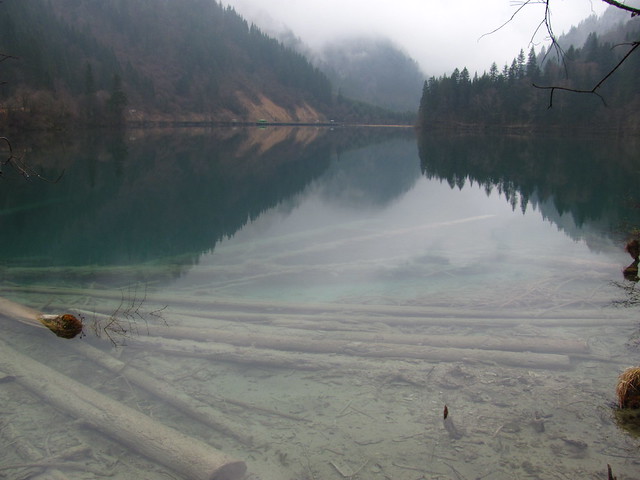



 This trail led to the Arrow Bamboo Lake Waterfall.
This trail led to the Arrow Bamboo Lake Waterfall.
 The trail first led around the top of the waterfall…
The trail first led around the top of the waterfall…

 …before seeing the Arrow Bamboo Lake Waterfall from below.
…before seeing the Arrow Bamboo Lake Waterfall from below.




 I’m usually don’t like getting my picture taken, but I had traveled so far to get here I figured I’d ask the Canadian couple for one so I wouldn’t regret it later. (Since then, my wife has told me this is her favorite photo of me from the time before we met.)
I’m usually don’t like getting my picture taken, but I had traveled so far to get here I figured I’d ask the Canadian couple for one so I wouldn’t regret it later. (Since then, my wife has told me this is her favorite photo of me from the time before we met.)
 It was a bit of a hike to the next destination.
It was a bit of a hike to the next destination.


 The water of Panda Lake was surreally clear and turquoise, almost looking like a giant mini-golf pond.
The water of Panda Lake was surreally clear and turquoise, almost looking like a giant mini-golf pond.


 While overall the park was very nicely kept, some of the trails felt a little precarious.
While overall the park was very nicely kept, some of the trails felt a little precarious.
 Still some snow to be found even as the morning began to warm.
Still some snow to be found even as the morning began to warm.
 Jiuzhaigou Valley consists of a series of stepped lakes, some with impressive waterfalls connecting them, others just some winding nature trails. Moving on to the next lake…
Jiuzhaigou Valley consists of a series of stepped lakes, some with impressive waterfalls connecting them, others just some winding nature trails. Moving on to the next lake…
So far each lake has been more spectacular than the previous. I might have gotten tired of walking around so many lakes but this next one was a real stunner.
The high concentration of calcium carbonate in the lakes of Jiuzhaigou produce some otherworldly colors and clarity, while also preserving any tree branches or logs that fall in. The various colors correspond to the lake’s depth, with different mineral and biologic factors at the different levels.
It’s like peering into an alien world.
 Unfortunately by this point in the morning many of the crowds started to catch up with us. We opted to keep moving to avoid the popular congested areas.
Unfortunately by this point in the morning many of the crowds started to catch up with us. We opted to keep moving to avoid the popular congested areas.
 If the first part of Jiuzhaigou heavily features lakes, this next part is where many of its most famous stepped waterfalls are found…
If the first part of Jiuzhaigou heavily features lakes, this next part is where many of its most famous stepped waterfalls are found…
 First up is Pearl Shoals. Not quite a waterfall, but more of a shallow cascading river overflowing down the hillside. The effect is quite mesmerizing.
First up is Pearl Shoals. Not quite a waterfall, but more of a shallow cascading river overflowing down the hillside. The effect is quite mesmerizing.
 Continuing down the trail, waterfalls appear in every direction.
Continuing down the trail, waterfalls appear in every direction.

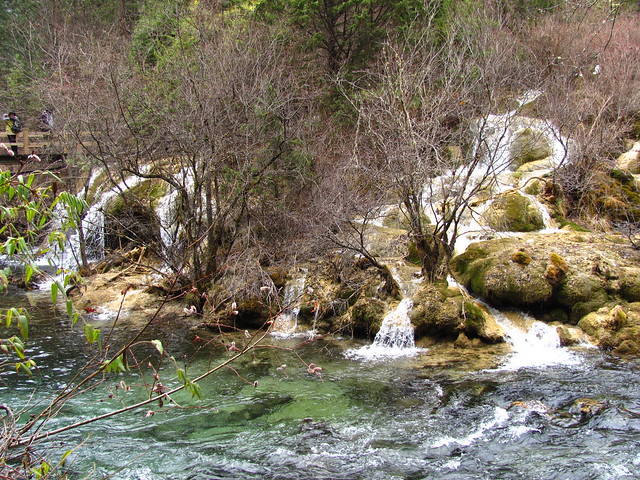
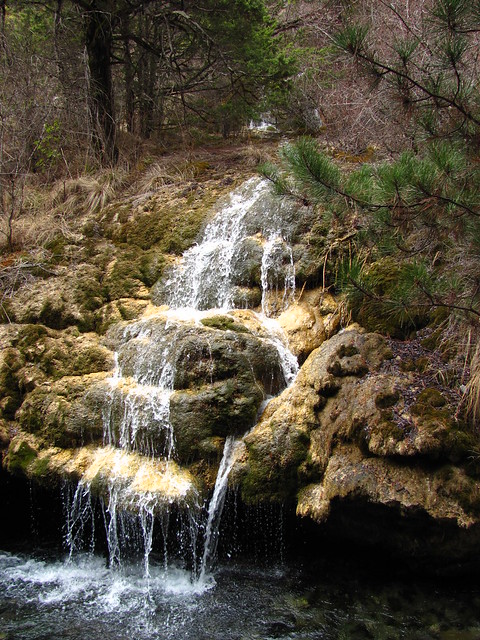

 This eventually culminates in the impressive Pearl Shoal Waterfall.
This eventually culminates in the impressive Pearl Shoal Waterfall.



 After a quick rest break beneath the prayer flags, it was onward down the valley. There’s still a lot more ground to cover… and it wasn’t even quite noon!
After a quick rest break beneath the prayer flags, it was onward down the valley. There’s still a lot more ground to cover… and it wasn’t even quite noon!


 More lakes. Okay, maybe now I’m started to get just a little bit bored of these lakes.
More lakes. Okay, maybe now I’m started to get just a little bit bored of these lakes.


 The Nuo Ri Lang Waterfall. Almost looks as if it was sculpted by Gaudí.
The Nuo Ri Lang Waterfall. Almost looks as if it was sculpted by Gaudí.



 Okay, I’ll get one more photo of me here as well…
Okay, I’ll get one more photo of me here as well…
 I’m not quite sure why this area at a lower altitude in the valley randomly kept a bunch of unmelted snow.
I’m not quite sure why this area at a lower altitude in the valley randomly kept a bunch of unmelted snow.
 We finally made it back to the visitor center… in the middle of the park. At this point it was time to bid farewell to my new Canadian friends (for the time being; we’d reconvene back in the hostel that evening) and complete the rest of the park solo. I had a hearty breakfast and would be skipping the line for lunch to keep powering onward.
We finally made it back to the visitor center… in the middle of the park. At this point it was time to bid farewell to my new Canadian friends (for the time being; we’d reconvene back in the hostel that evening) and complete the rest of the park solo. I had a hearty breakfast and would be skipping the line for lunch to keep powering onward.
While most of Jiuzhaigou is in the main valley that we’d been walking, there’s a second valley connected to this central rest point with a couple of sights to see. It’s much too far to walk, but fortunately I could use my bus pass to get off my feet for a few minutes. I actually fell asleep on the ride, which was all the boost I needed to keep going for the rest of the day.
 The first stop was at Long Lake, the largest in Jiuzhaigou National Park. This one was too big to walk around; just a few photos at the viewing platform from the far end would suffice.
The first stop was at Long Lake, the largest in Jiuzhaigou National Park. This one was too big to walk around; just a few photos at the viewing platform from the far end would suffice.
It appeared to still be frozen.
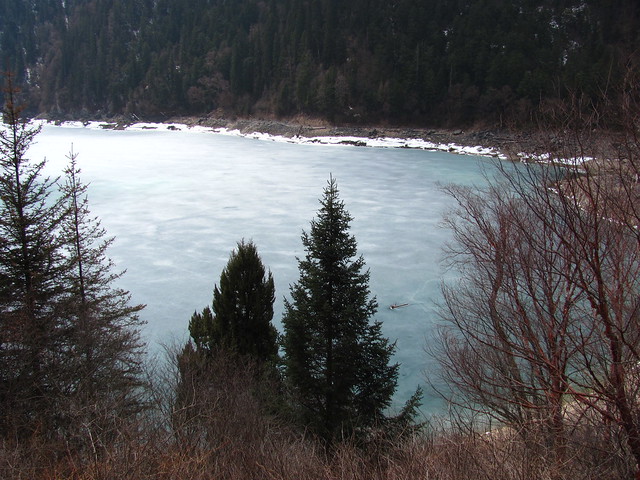
 It’s a spectacular setting. Too bad by the rest of Jiuzhaigou’s standard that a simple lake amid mountains could already feel just a tad generic.
It’s a spectacular setting. Too bad by the rest of Jiuzhaigou’s standard that a simple lake amid mountains could already feel just a tad generic.

 The next stop is the opposite of Long Lake as one of Jiuzhaigou’s smallest but most distinctive bodies of water, as well as possibly its most famous feature: The Five-Coloured Pool.
The next stop is the opposite of Long Lake as one of Jiuzhaigou’s smallest but most distinctive bodies of water, as well as possibly its most famous feature: The Five-Coloured Pool.
This pool is famous for its five layers of colors, reacting to the various mineral strata in its basin. Unfortunately they were experiencing a bit of a drought and the pool wasn’t filled to its normal levels. As a result it was more of a Three-Coloured Pool. Still very pretty.
While I’m glad I took the time to see both of these features, I found I much preferred a more active mode of hiking and discovering landscapes away from the crowds, instead of being bused to just stand and look at the most popular tourist sites.
 Back at the visitor center, it’s time to continue down the main trail.
Back at the visitor center, it’s time to continue down the main trail.
Tiger Lake. I have nothing more to add about it, other than I saw no evidence of tigers.

 One of the last major waterfalls along the trail: Shu Zheng Falls.
One of the last major waterfalls along the trail: Shu Zheng Falls.




 This waterfall didn’t quite have a properly defined river to flow into but just kind of flows out into the surrounding landscape. I’m presuming it must be seasonal for these plants and trees to grow here.
This waterfall didn’t quite have a properly defined river to flow into but just kind of flows out into the surrounding landscape. I’m presuming it must be seasonal for these plants and trees to grow here.



 An old stone mill house was located by the water’s edge, used to grind wheat or barley used for traditional Tibetan barley wine.
An old stone mill house was located by the water’s edge, used to grind wheat or barley used for traditional Tibetan barley wine.



 Continuing down through what’s known as the Shu Zheng Lakes. Again, it’s a wild landscape to walk through and be reminded that this is all somehow real and natural.
Continuing down through what’s known as the Shu Zheng Lakes. Again, it’s a wild landscape to walk through and be reminded that this is all somehow real and natural.
One of the Tibetan villages of Jiuzhaigou.
 Further down the trail there were yet more stepped lakes to be found. By this point I stopped recording the names of them all.
Further down the trail there were yet more stepped lakes to be found. By this point I stopped recording the names of them all.

 Even if I didn’t get its name, the clear blue water is still mesmerizing.
Even if I didn’t get its name, the clear blue water is still mesmerizing.



 In a somewhat unrelated story, when I was in first grade I wrote “cerulean” on a quiz asking for my favorite color and the teacher marked it wrong.
In a somewhat unrelated story, when I was in first grade I wrote “cerulean” on a quiz asking for my favorite color and the teacher marked it wrong.

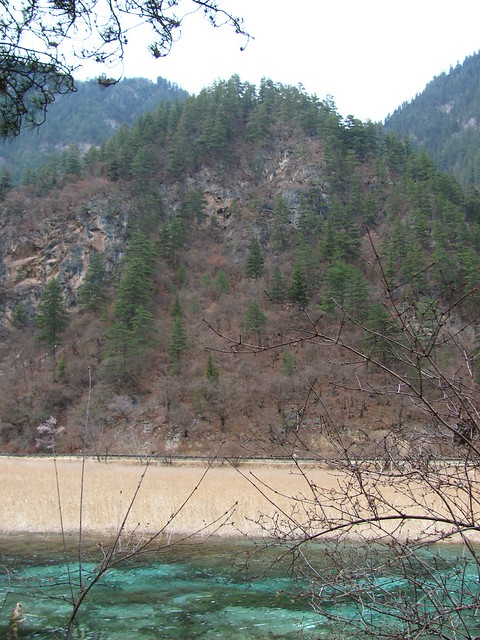
 The lower part of the valley began to open up and flatten out with lots of reeds and tall grasses, almost reminiscent of a landscape in the American west. Most of the tourists skipped this portion with the bus service, which made for a peaceful walk.
The lower part of the valley began to open up and flatten out with lots of reeds and tall grasses, almost reminiscent of a landscape in the American west. Most of the tourists skipped this portion with the bus service, which made for a peaceful walk.
The amount of ecological diversity within this valley that can be reached by foot was quite incredible. I felt like I had walked through at least three of the four seasons in a single day.



 Passing by another Tibetan village, the pathway soon became much less maintained. By this point I was very literally the only person on the trail. I still had several kilometers to go before arriving back at the entrance.
Passing by another Tibetan village, the pathway soon became much less maintained. By this point I was very literally the only person on the trail. I still had several kilometers to go before arriving back at the entrance.



 The trail soon led back into the woods, running alongside the river rapids. I still had several kilometers of steady walking before I’d make it back to the village. While there were no major landmarks along this part of the trail, I was able to simply focus on the task of walking without distraction or interruption, listening only to the roar of the river rapids and my own footsteps and breaths, free to think about how far I’d come in so many different ways. Looking back, this was still for me one of the best parts of the day. Plus it was all at a gentle downhill grade, ideal for long-distance walking.
The trail soon led back into the woods, running alongside the river rapids. I still had several kilometers of steady walking before I’d make it back to the village. While there were no major landmarks along this part of the trail, I was able to simply focus on the task of walking without distraction or interruption, listening only to the roar of the river rapids and my own footsteps and breaths, free to think about how far I’d come in so many different ways. Looking back, this was still for me one of the best parts of the day. Plus it was all at a gentle downhill grade, ideal for long-distance walking.





 A brief sign of civilization. Just over one kilometer left to go…
A brief sign of civilization. Just over one kilometer left to go…
Finally back to civilization.


 When I look back on my travels across Asia over nine years later, the journey to Jiuzhaigou still stands apart in my memory from everything else. Not because it was necessarily top of my list of places to visit, but because it was the kind of place I never expected I’d get to see and am still kind of shocked that I did. Jiuzhaigou was the furthest from home I’ve ever been, yet it was also one of the places in Asia I felt the most comfortable and at ease within, a natural setting to which everyone, no matter where we were from, were all equally visitors to this beguiling place.
When I look back on my travels across Asia over nine years later, the journey to Jiuzhaigou still stands apart in my memory from everything else. Not because it was necessarily top of my list of places to visit, but because it was the kind of place I never expected I’d get to see and am still kind of shocked that I did. Jiuzhaigou was the furthest from home I’ve ever been, yet it was also one of the places in Asia I felt the most comfortable and at ease within, a natural setting to which everyone, no matter where we were from, were all equally visitors to this beguiling place.
It very well ranks among the top national parks I’ve been to, not that I’ve been to enough yet. From snowy forests to crystal technicolor lakes to surreal waterfalls to the rambling backwoods trails, Jiuzhaigou not only has some of the most spectacular natural scenery I’ve seen, but the park is at a pleasantly human scale. While a bit ambitious, it is completely walkable within a single twelve hour day as I set out to prove, with the progression and reveal of new landmarks and environments never ceasing to surprise from the early dawn mist to the early evening shadows. While it’s too far away for me to say with confidence that I’ll return some day, Jiuzhaigou will definitely serve as inspiration to go the extra mile to discover the natural world.
trails, Jiuzhaigou not only has some of the most spectacular natural scenery I’ve seen, but the park is at a pleasantly human scale. While a bit ambitious, it is completely walkable within a single twelve hour day as I set out to prove, with the progression and reveal of new landmarks and environments never ceasing to surprise from the early dawn mist to the early evening shadows. While it’s too far away for me to say with confidence that I’ll return some day, Jiuzhaigou will definitely serve as inspiration to go the extra mile to discover the natural world.
Now, back at the hostel, it was time for a hot shower and a hot meal before another long day of travel…
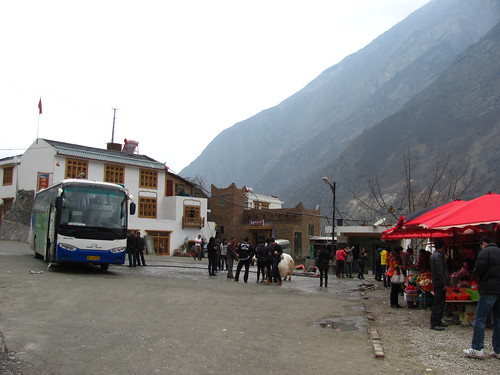


























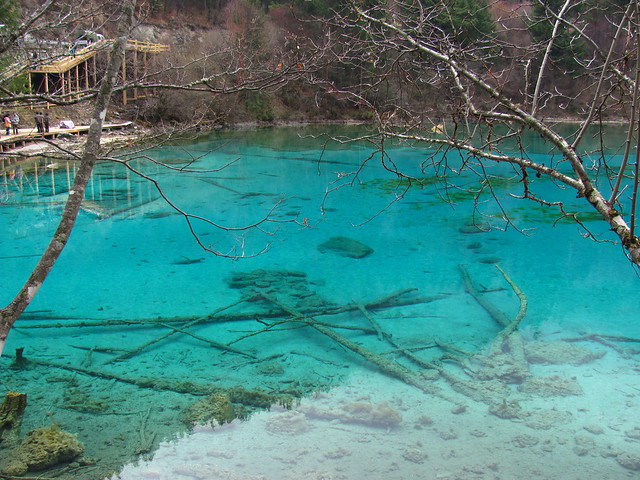








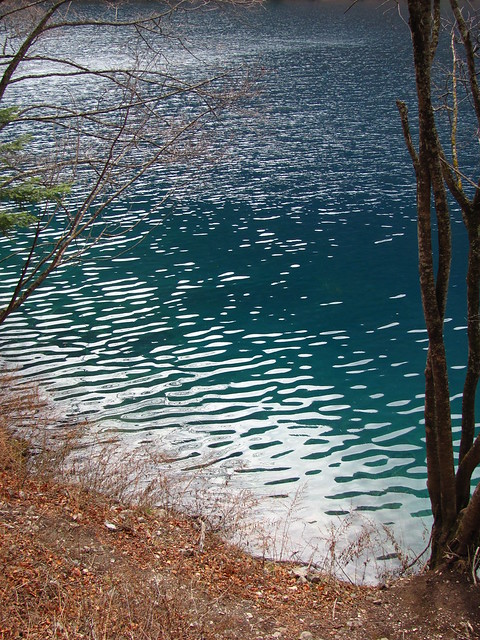



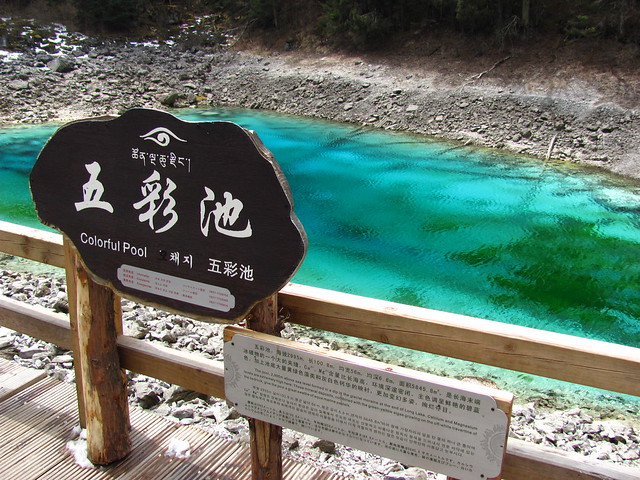










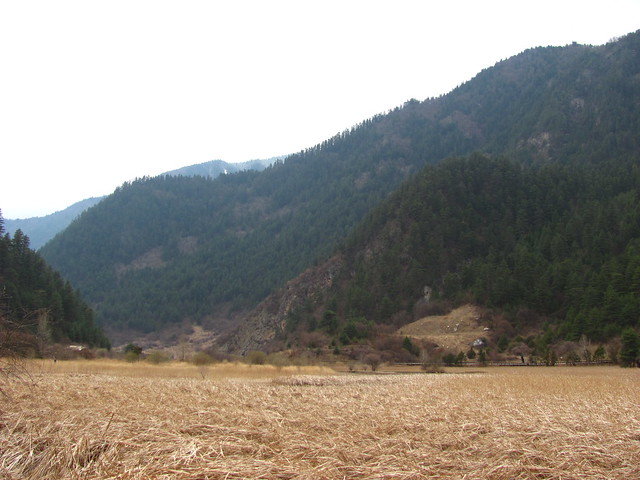



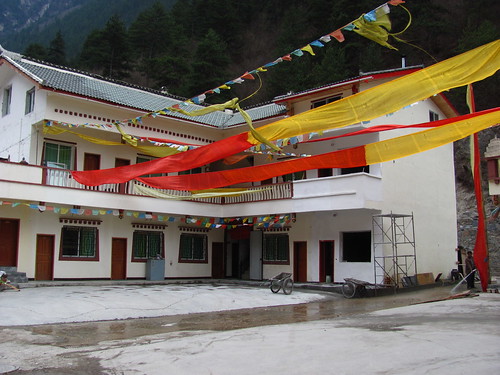
Comments